Disable Hardware Acceleration in Group Policy
The hardware acceleration is a characteristic that offloads some of the CPU'southward loading tasks to other hardware. This characteristic boosts browser performance as well as freeing up the CPU to handle some other tasks. The hardware dispatch will be enabled by default in all browsers. Withal, sometimes some problems can occur due to the hardware acceleration selection in the browser. Information technology tin also decrease the performance of the browser. In that case, y'all can simply disable hardware dispatch to check if it fixes the issues. The performance when hardware acceleration is ON or OFF also depends on the figurer system.

In this article, you will find methods through which y'all tin disable the hardware dispatch in Mozilla Firefox, Google Chrome, and Microsoft Edge. If it causes a performance outcome, so yous can also enable it back past using the same methods.
1. Enable or Disable Hardware Acceleration in Microsoft Edge
1.1 Using Microsoft Edge's Settings to Disable/Enable HA
The most common method would be by using the Microsoft Edge browser'south settings. The option for Hardware Acceleration is already available in the browser settings. Y'all only demand to toggle ON or toggle OFF the option. However, as an administrator, if yous want to disable this option for standard users, then effort using the other methods.
- Open the Microsoft Border browser by double-clicking on the shortcut or searching it through the Windows search feature.
- Click on the Settings and more option at the top correct corner and choose the Settings option in the listing.
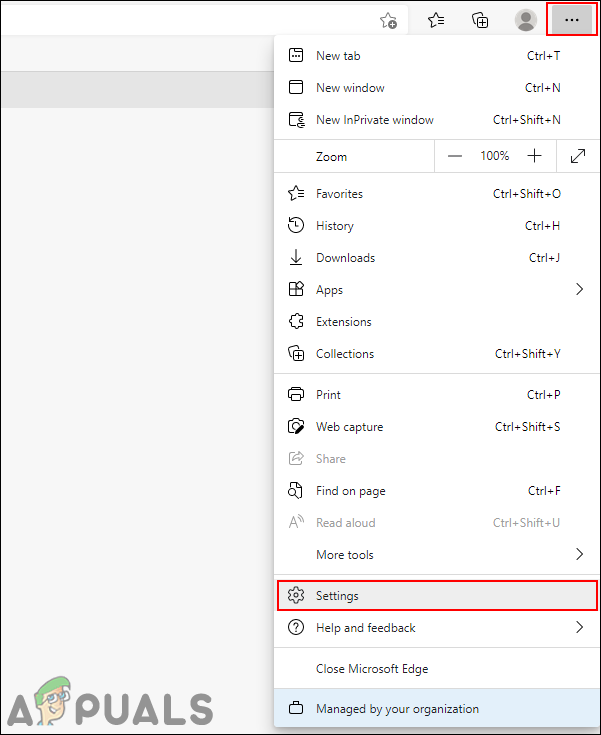
Opening Microsoft Border settings - Select the System pick in the left pane. At present, plow OFF the toggle for the "Apply hardware acceleration when available" option.
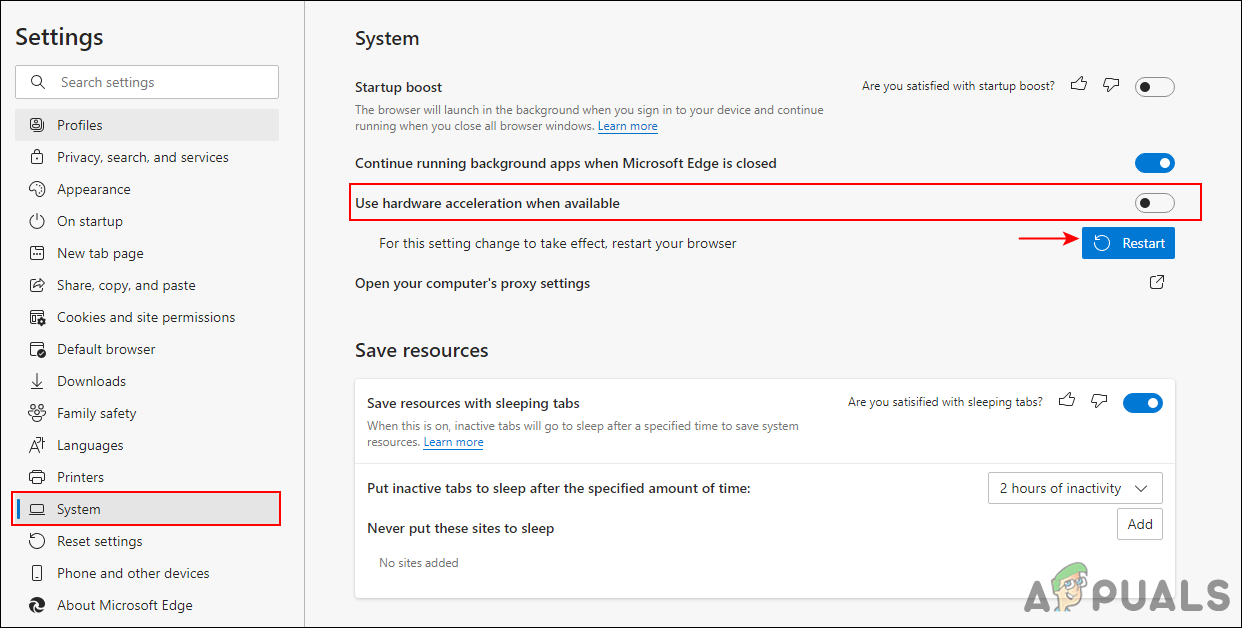
Disabling the hardware dispatch - Click on the Restart button to restart the Microsoft Edge with new changes.
1.2 Using the Registry Editor to Disable/Enable HA in Border
This method can help you lot in force enabling and disabling the hardware acceleration for the Microsoft Edge browser. Information technology will prevent the standards users from irresolute the option in the futurity. It volition crave some technical steps to configure the setting in the Registry. You need to create the value and peradventure a key to configure the setting. Follow the below steps and see how it can be done.
The value can be configured in both the Current Auto and Electric current User hives. The location path for both will be the aforementioned, only the hives will be different.
- Open up the Run dialog box by pressing the Windows + R keys together on your keyboard. Now blazon "regedit" in the box and press the Enter fundamental to open the Registry Editor.
Note: If yous become a UAC (User Account Control) prompt, so simply click on the Yes option.
Opening the Registry Editor - You can also create a backup to be safe, by clicking on the File menu and choosing the Export choice. Now just provide the name/path and click on the Save button.
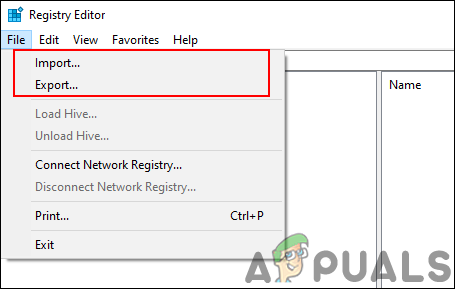
Creating registry backup Note: If you desire to restore the backup, simply click on the File card in the menu bar and choose the Import selection.
- In the Registry Editor window, navigate to the following location:
HKEY_LOCAL_MACHINE\Software\Policies\Microsoft\Edge
Annotation: If the Edge key is missing the path, then right-click on the Microsoft central and cull the New > Key selection. Name the fundamental equally "Edge" and save it.
- Correct-click on the right pane of the Border key and choose the New > DWORD (32-bit) Value selection. Rename the value equally "HardwareAccelerationModeEnabled" and save information technology.
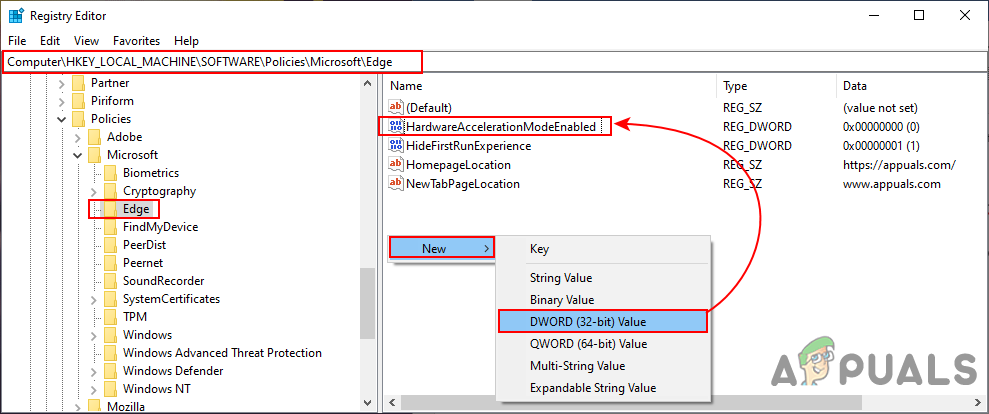
Creating a new value - Now double-click on the HardwareAccelerationModeEnabled value to open the value data dialog. Then change the value data to 0.
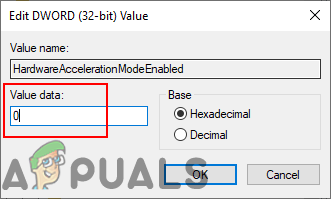
Irresolute the value information - After that, shut the Registry Editor window. Make sure you lot restart the computer to employ these new changes.
- You can e'er enable it back by changing the value data to 1. Another way to enable this is by removing the value from the Registry Editor.
1.3 Using the Local Group Policy Editor to Disable/Enable HA in Edge
The policy files for the latest Microsoft Edge may non be available on your organization. That is why you lot need to download the latest policy files and add together them to your system policy settings folder. Information technology will take few extra steps, merely it will provide all the policy settings for the latest Microsoft Border. The setting can be found nether both Reckoner Configuration and User Configuration categories. Check the below steps to install and configure this specific policy setting for Microsoft Edge.
Note: Skip this method if you are using a Windows 10 Abode edition operating system.
- Open your browser and get to the Microsoft site. Now select the version details of your Microsoft Edge and click on the Get POLICY FILES button.
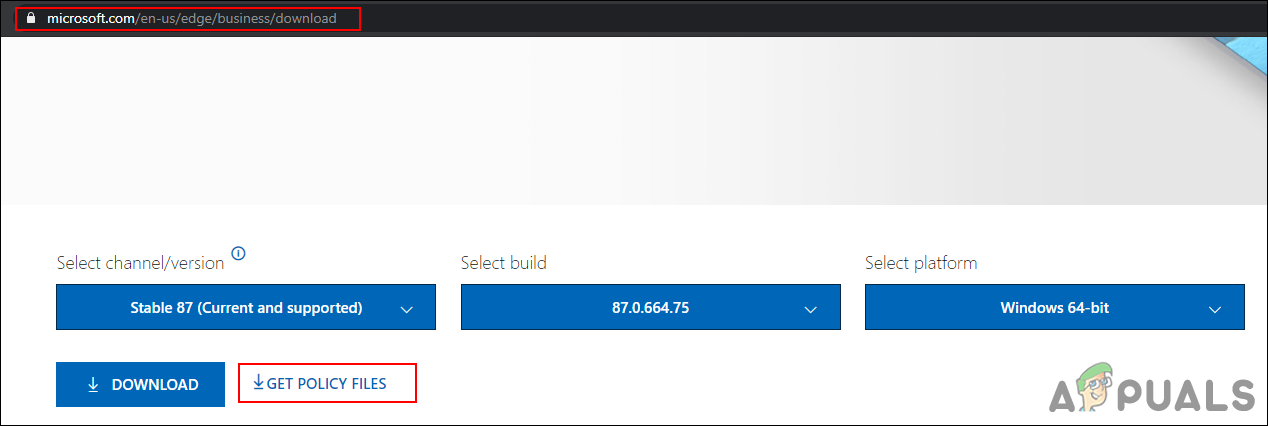
Installing new policy files - Utilise the WinRAR application to extract the downloaded policy zip file.
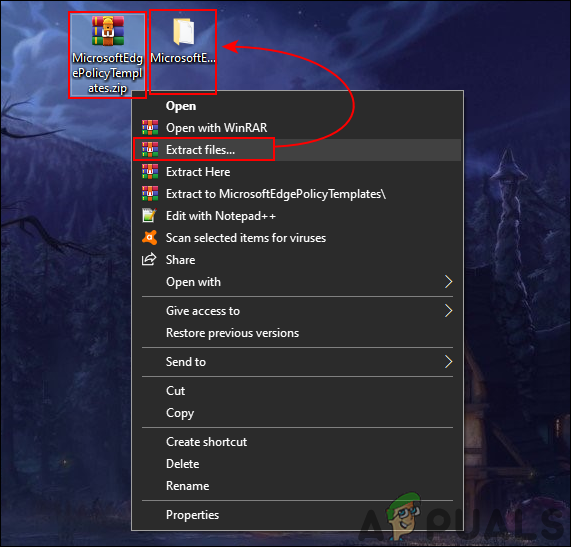
Using WinRAR to excerpt - Open the extracted folder and head over to the "MicrosoftEdgePolicyTemplates\windows\admx" path. Yous demand to re-create the "msedge.admx" and "msedge.adml" files and then paste them into "C:\Windows\PolicyDefinitions" folder.
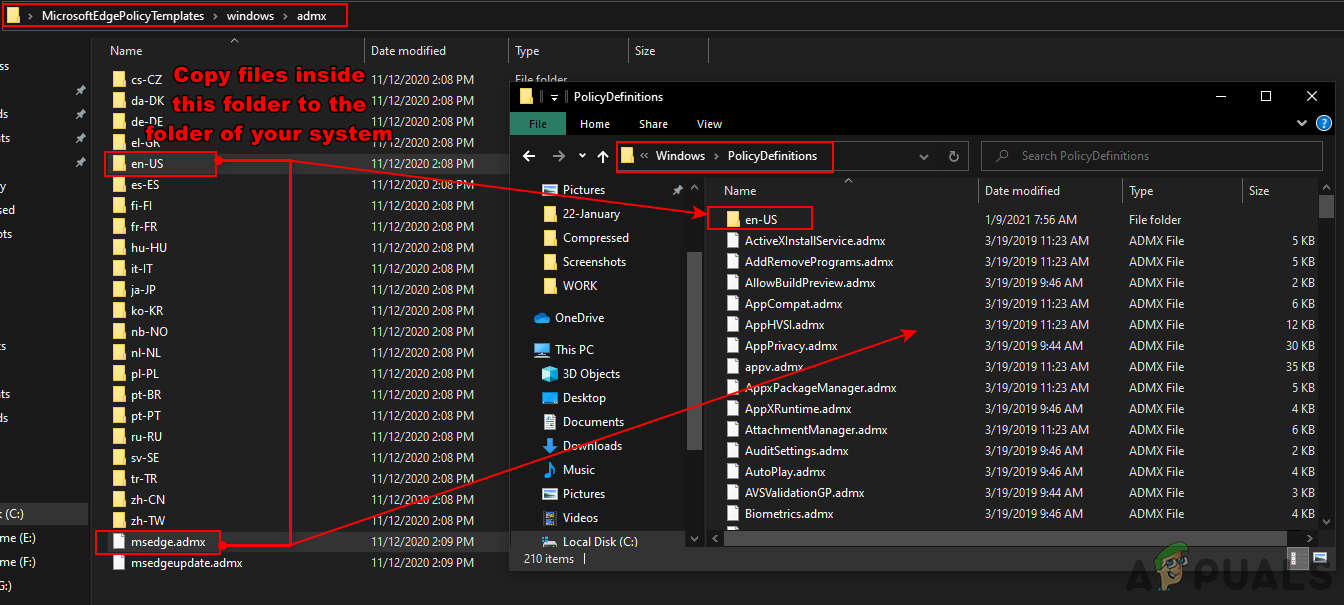
Copy new policy files to the system folder Note: The ADML file can exist establish in the language binder, then you tin can copy it from i linguistic communication folder to another.
- Open the Run dialog box by pressing the Windows and R keys together. And so but type "gpedit.msc" in the box and press the Enter key to open the Local Group Policy Editor window.
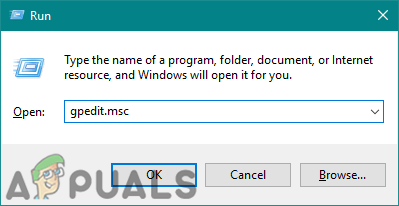
Open the group policy editor - Navigate to the specific setting in the Local Group Policy Editor window:
Computer Configuration\ Administrative Templates\ Microsoft Border\

Navigate to the setting - Double-click on the setting named "Use hardware dispatch when available" and it will open up in another window. Now you demand to select the Disabled toggle option.

Disabling the hardware acceleration - Click on the Apply/Ok button and shut the Local Group Policy Editor window.
- Y'all can always enable it back by irresolute the toggle pick back to Non Configured or Enabled.
ii. Enable or Disable Hardware Acceleration in Google Chrome
2.1 Using the Browser Settings to Disable/Enable HA in Chrome
Like all other browsers, Google Chrome likewise has the hardware acceleration option in the settings. Yous can navigate to the settings and turn ON or turn OFF the toggle for the hardware acceleration. If the option is grayed out, and so check the other methods.
- Open your browser and click on the 3 dots menu option at the pinnacle right corner. Now select settings in the list.
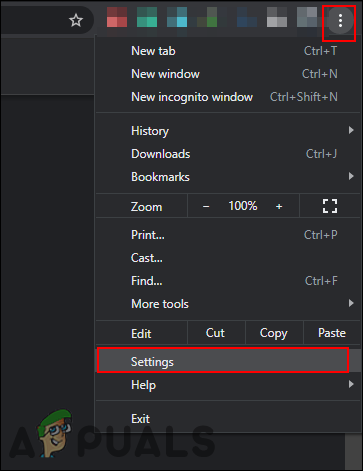
Opening Chrome settings - In the left pane, click on the Advanced option and then click on System.
- At present you can plough OFF or plow ON the toggle selection for the "Use hardware acceleration when available".
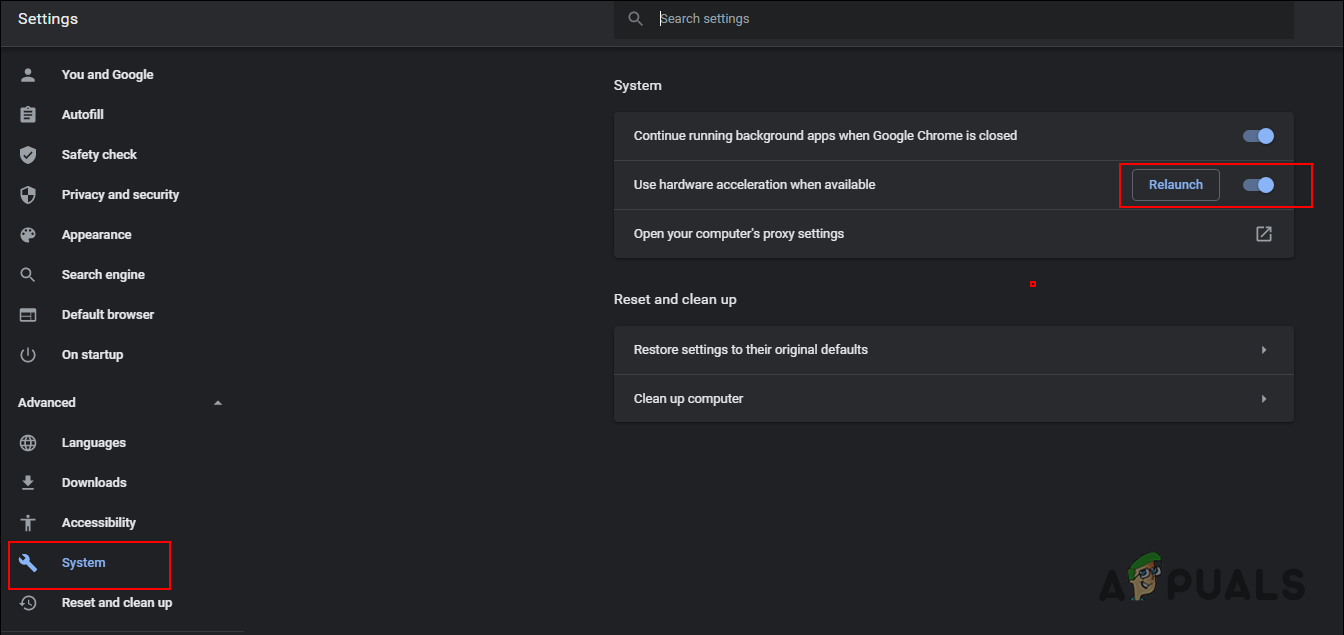
Disabling hardware acceleration in Chrome - Click on the Relaunch push to apply the new changes for hardware acceleration.
ii.2 Using the Registry Editor to Enable/Disable HA in Chrome
The hardware acceleration for Google Chrome tin also be configured in the Registry. The Google central is located in several locations in the Registry, make certain you lot follow the correct path. Information technology tin can as well be configured for both the Local Machine and the Current User.
- Printing the Windows + R keys together on your keyboard to open Run. At present blazon "regedit" in the box and press the Enter fundamental to open the Registry Editor.
Note: If you go a UAC (User Business relationship Control) prompt, then simply click on the Yep choice.
Opening Registry Editor - You tin can too create a fill-in to be prophylactic, by clicking on the File menu and choosing the Export selection. Now just provide the proper name/path and click on the Save button.
Note: If y'all want to restore the backup, simply click on the File card in the menu bar and choose the Import choice. - In the Registry Editor window, navigate to the following location:
HKEY_LOCAL_MACHINE\Software\Policies\Google\Chrome
Note: If the Google or Chrome key is missing in the path, then right-click on the Policies primal and choose the New > Key pick.
- Right-click on the right pane of the Chrome key and cull the New > DWORD (32-flake) Value selection. Rename the value as "HardwareAccelerationModeEnabled" and salvage it.
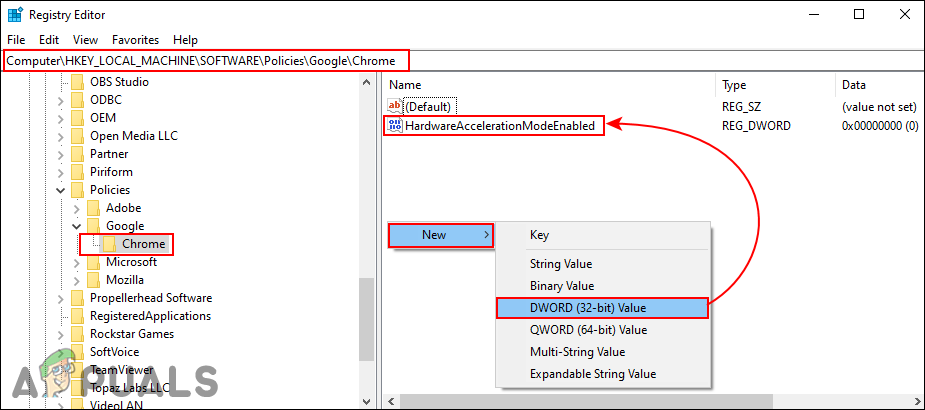
Creating a new value - Now double-click on the HardwareAccelerationModeEnabled value to open the value information dialog. Then change the value information to 0.
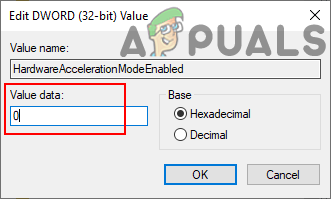
Changing value data - Later on that, close the Registry Editor window. Make certain you lot restart the computer to apply these new changes.
- You can ever enable information technology back by changing the value information to i. Another way to enable this is past removing the value from the Registry Editor.
Note: Value data 1 will force enable the hardware acceleration.
2.3 Using the Local Group Policy Editor to Enable or Disable HA in Chrome
The Google Chrome policies are not available by default in Windows operating system. You need to download it from the Chrome Enterprise site. Y'all can download the files for both 32-flake and 64-bit.
- Open up your browser and go to the Google Chrome enterprise parcel page. Now click on the Download button for the operating system that you are using.
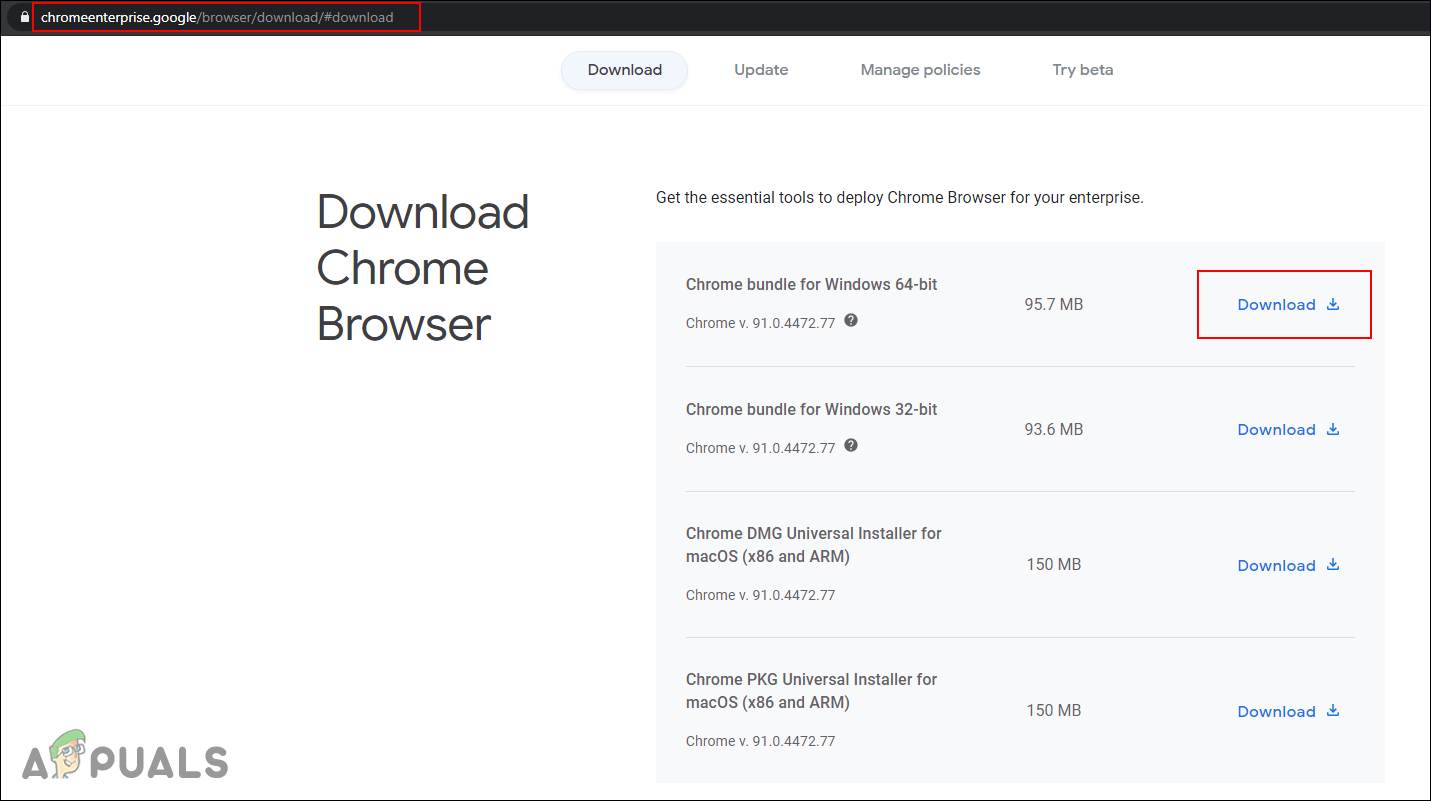
Downloading Chrome policy files - Use the WinRAR application to excerpt the downloaded Chrome parcel zilch file.
- Open the extracted folder and head over to the "GoogleChromeEnterpriseBundle64\Configuration\admx" path. You need to copy the "chrome.admx" and "google.admx" files and then paste them into "C:\Windows\PolicyDefinitions" folder.
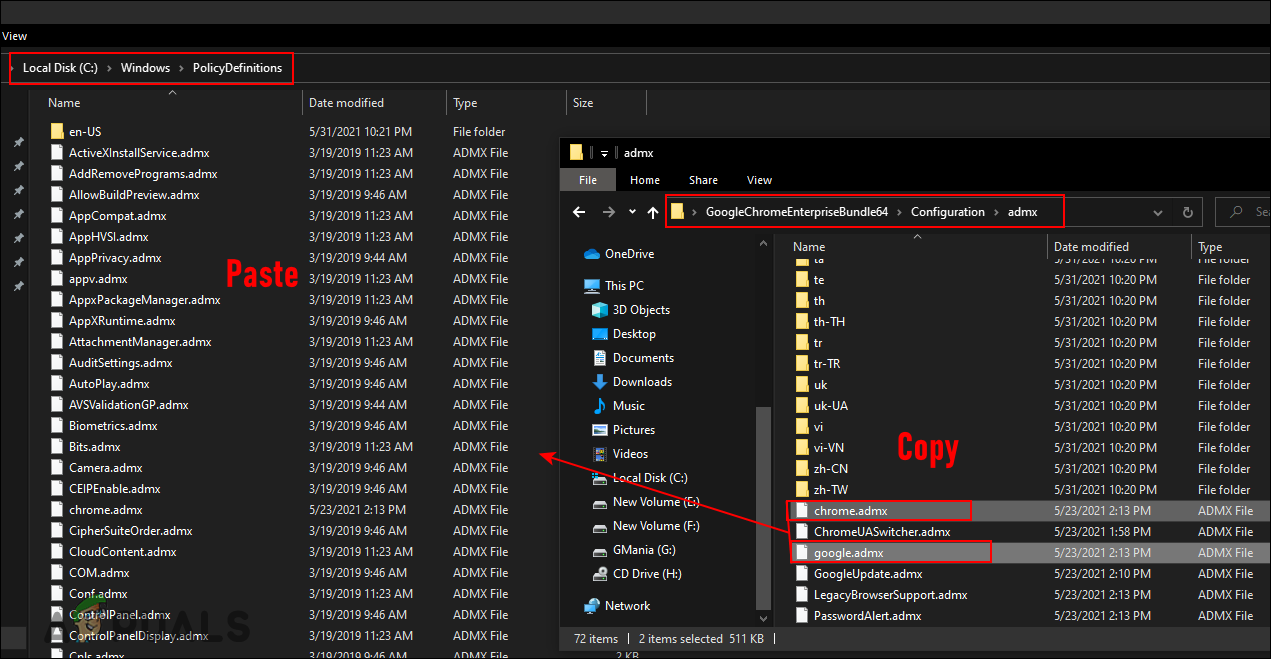
Copying files to system policy folder - Too, copy the "chrome.adml" and "google.adml" from one of the language folders to your own aforementioned language binder in the aforementioned directory.
Note: In our case, we copied these files from the downloaded "en-U.s." binder to our "en-US" folder. - Open the Run dialog box by pressing the Windows and R keys together. So just type "gpedit.msc" in the box and press the Enter primal to open the Local Group Policy Editor window.

Opening the Group Policy Editor - Navigate to the specific setting in the Local Grouping Policy Editor window:
Figurer Configuration\ Authoritative Templates\ Google Chrome\
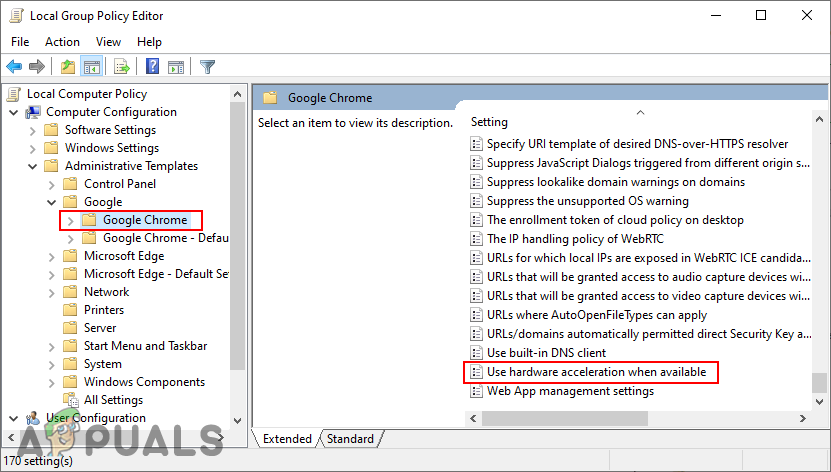
Navigate to settings - Scroll down the list, double-click on the setting named "Use hardware acceleration when available". Now modify the toggle selection to Disabled.

Disabling hardware dispatch in Chrome - Click on the Apply/Ok button and close the Local Grouping Policy Editor window.
- You can always enable information technology back by changing the toggle option back to Non Configured or Enabled.
Note: Enabled pick will force enable the hardware acceleration.
3. Enable/Disable Hardware Acceleration in Mozilla Firefox
3.ane Using the Browser Settings to Enable or Disable HA in Firefox
You lot can just enable and disable the hardware acceleration from Mozilla Firefox by using the browser settings. Both the administrator and standard users can access the option to configure it. The settings interface may change with the updates, just the choice will remain the same.
- Open your browser and click on the Application bill of fare at the top right corner. Now cull the Options in the list.
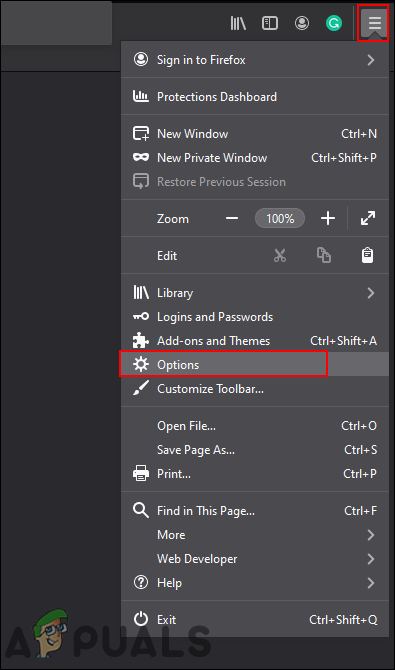
Opening Firefox settings - Select the General option in the left pane and whorl down. Uncheck the "Use recommended functioning settings" nether the Functioning section.
- Now you lot can uncheck the "Use hardware acceleration when available" to disable it.
- If y'all want to enable information technology, then you lot tin check the option to enable the hardware dispatch for your browser.

Disabling the hardware acceleration for Firefox - Make sure to restart the Mozilla Firefox browser after changing the settings.
3.two Using the Registry Editor to Enable/Disable Hardware Dispatch in Firefox
Y'all can besides configure a registry value for the Firefox browser. The value name for the hardware dispatch in Firefox volition be a bit dissimilar from the other browsers. Y'all tin configure it in both Current User and Local Machine hives.
- Open the Run dialog box by pressing the Windows + R keys together on your keyboard. Now blazon "regedit" in the box and press the Enter key.
Notation: Click on the Yes option for UAC prompt.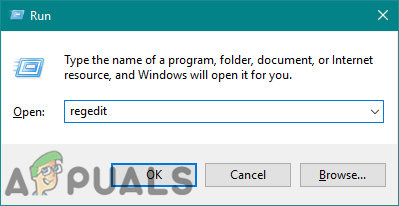
Opening the Registry Editor - You can besides create a backup to be safe, by clicking on the File > Export option. At present just provide the name/path and click on the Save button.
Note: If you want to restore the backup, but click on the File > Import choice. - In the Registry Editor window, navigate to the post-obit location:
HKEY_LOCAL_MACHINE\Software\Policies\Mozilla\Firefox
Note: If the Firefox key is missing in the path, then right-click on the Mozilla key and cull the New > Central selection. Proper noun the key as "Firefox" and relieve information technology.
- Right-click on the correct pane of the Firefox key and cull the New > DWORD (32-bit) Value choice. Rename the value as "HardwareAcceleration".

Creating a new value - At present double-click on the HardwareAcceleration value to open up. Then change the value information to 0.
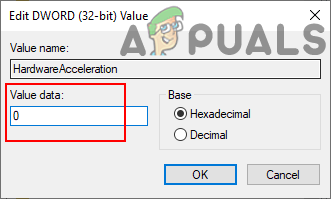
Changing the value information - Make certain you restart the reckoner to employ these new changes.
- Yous can always enable information technology dorsum past changing the value data to 1 or by removing the value from the Registry Editor.
3.three Using the Local Grouping Policy Editor to Disable/Enable Hardware Acceleration in Firefox
You can use Local Grouping Policy Editor to disable or enable hardware acceleration from Mozilla Firefox. Yet, the Firefox browser is a tertiary-party application, so the policy files will not be available on your system. Yous need to download it from their Github page. Make certain you download the latest policy files version. Then you demand to copy the files to your system.
- Open your browser and go to the Firefox Github page. Download the latest policy template zip file.
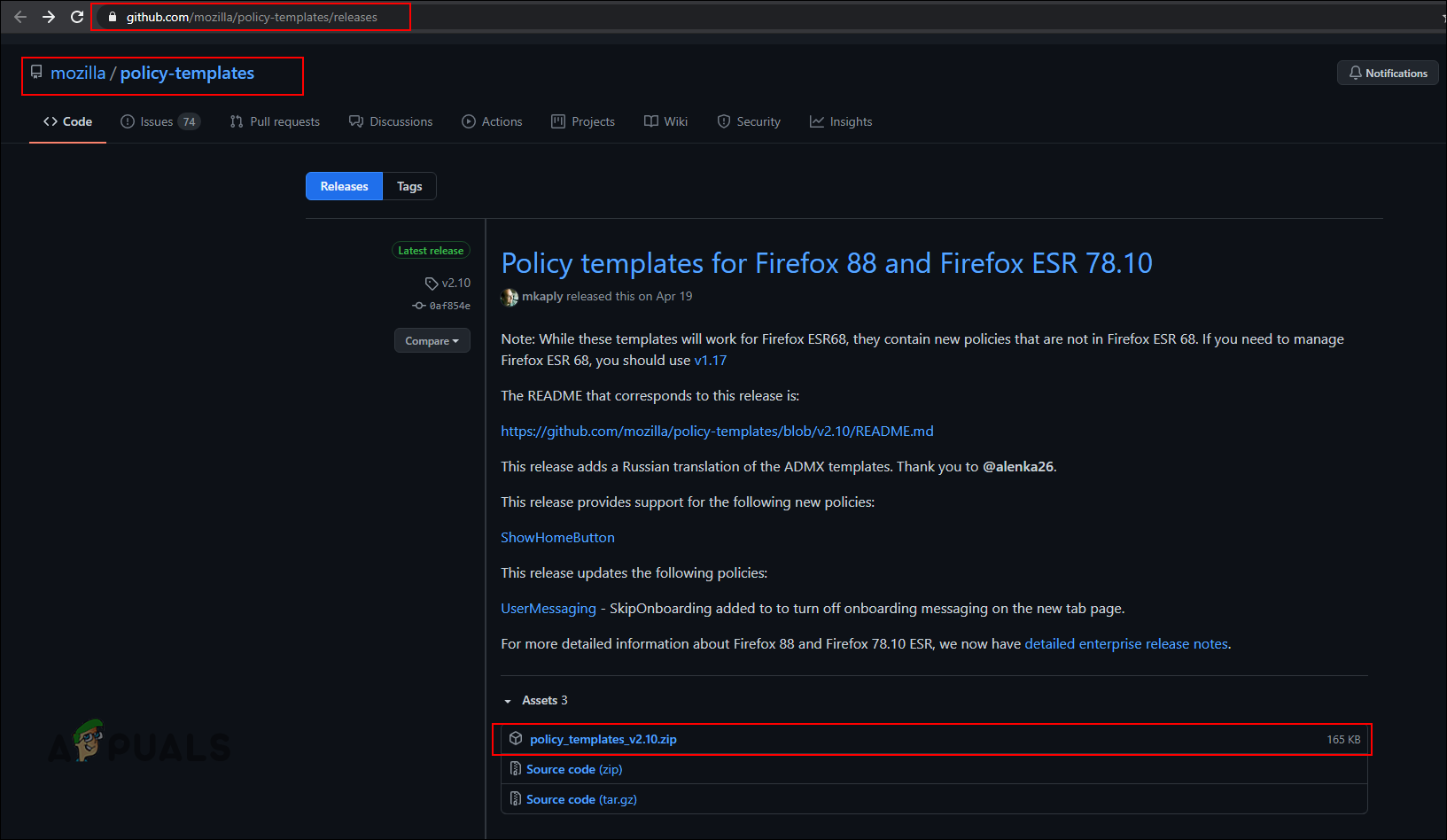
Downloading Firefox policy files - Use the WinRAR awarding to extract the downloaded policy template zilch file.
- Open the extracted folder and navigate to the "policy_templates_v2.10\windows" path. Yous need to copy the "firefox.admx" and "mozilla.admx" files and so paste them into "C:\Windows\PolicyDefinitions" folder.
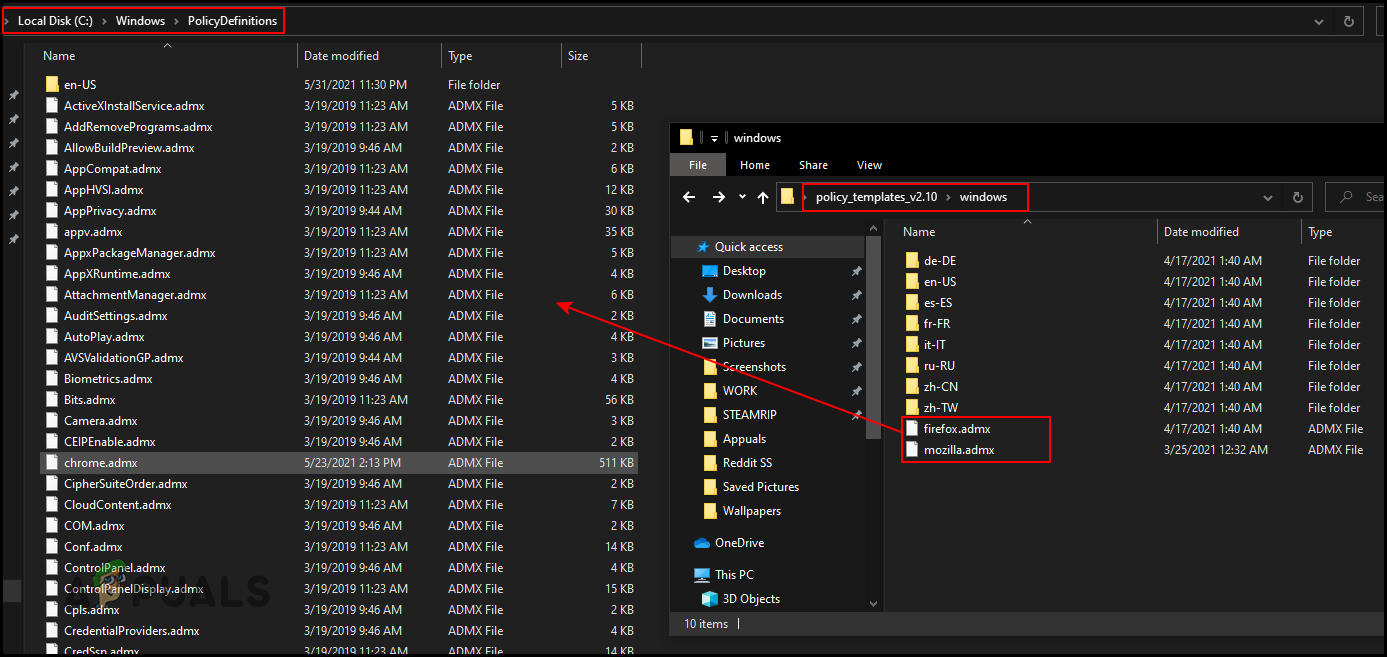
Copying policy files to system policy binder - Besides, copy the "firefox.adml" and "mozilla.adml" from one of the language folders to your own aforementioned language binder in the aforementioned directory.
Note: In our case, we copied these files from one "en-US" folder to another. - Open up the Run box by pressing the Windows and R keys together. So but type "gpedit.msc" in the box and printing the Enter cardinal to open the Group Policy Editor window.
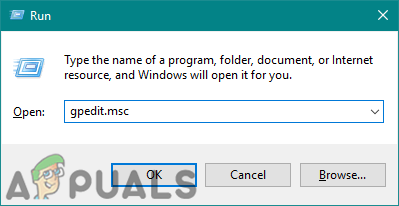
Opening Group Policy Editor - Navigate to the specific setting in the Local Group Policy Editor window:
Reckoner Configuration\ Authoritative Templates\ Mozilla\ Firefox
Navigating to the settings - Coil down the list, double-click on the setting named "Hardware Acceleration". Now modify the toggle option to Disabled.
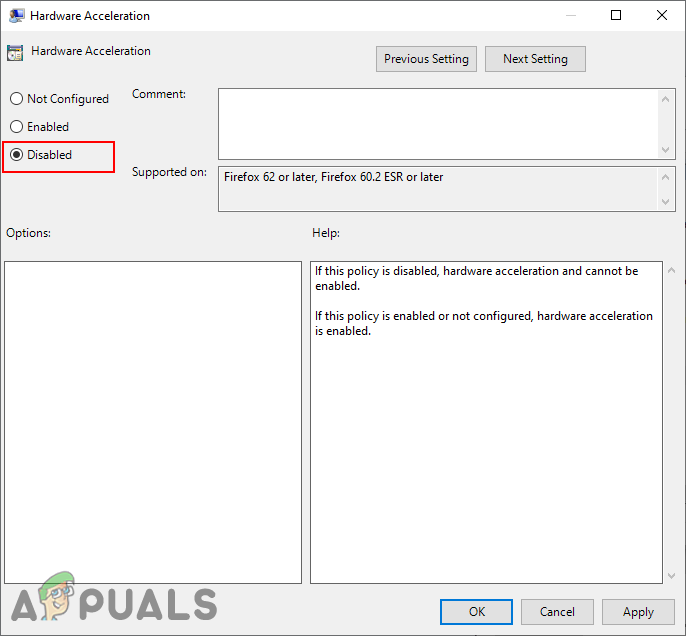
Disabling the hardware dispatch - Click on the Apply/Ok button to save the settings.
- You lot can always enable it back past changing the toggle selection dorsum to Non Configured or Enabled.
0 Response to "Disable Hardware Acceleration in Group Policy"
Post a Comment